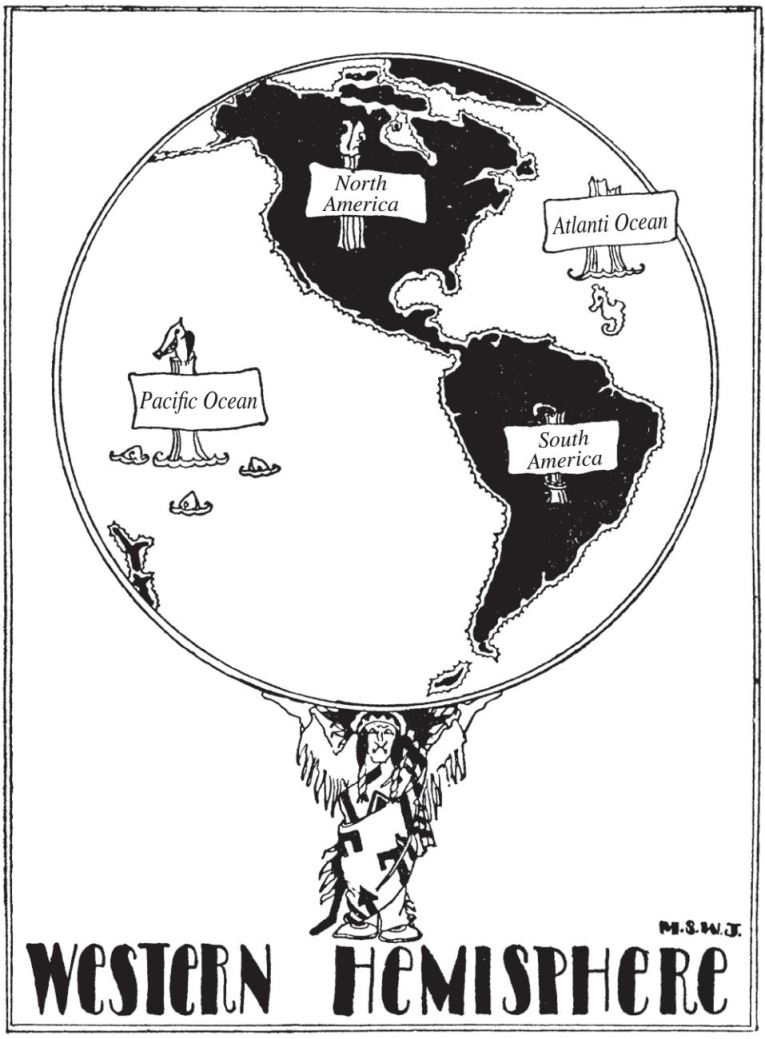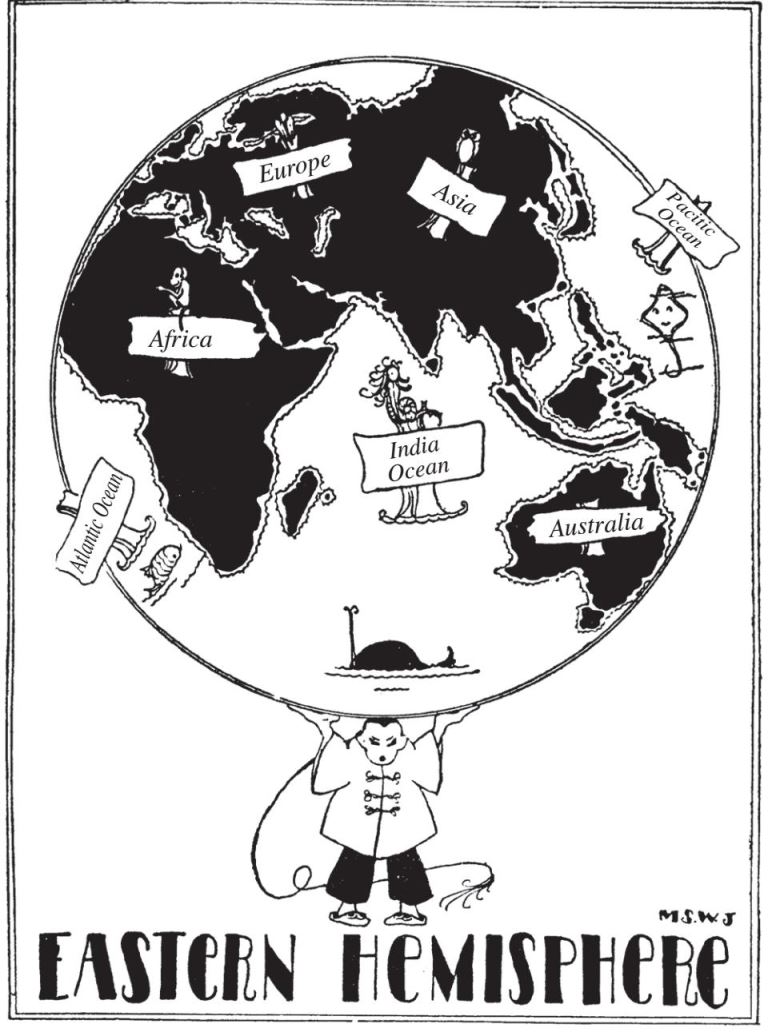




 01 The World Through a Spy-Glass
01 The World Through a Spy-Glass
You have never seen your own face.
This may surprise you and you may say it isn’t so—but it is so.
You may see the end of your nose.
You may even see your lips if you pout out—so.
If you stick out your tongue you may see the tip of it.
But you can’t go over there, outside of yourself, and look at your own face.
Of course you know what your face looks like, because you have seen it in a mirror; but that’s not yourself—it’s only a picture of yourself.
And in the same way no one of us can see our own World—all of it—this World on which we live.
You can see a little bit of the World just around you—and if you go up into a high building you can see still more—and if you go up to the top of a high mountain you can see still,still more—and if you go up in an airplane you can see still,still, still more.
But to see the Whole World you would have to go much higher than that, higher than any one has ever been able to go or could go. You would have to go far, far above the clouds;way, way off in the sky where the stars are—and no one can do that, even in an airplane.
Now you cannot see the World in a mirror as you can see your face. So how do we know what the World looks like ?
A fish in the sea might tell her little fish, “The World is all water—just a huge tub; I’ve been everywhere and I know.”Of course, she wouldn’t know anything different.
A camel in the desert might tell her little camels, “The World is all sand—just a huge sand pile; I’ve been everywhere and I know.”
A polar bear on an iceberg might tell her little polar bears,“The World is all snow and ice—just a huge refrigerator; I’ve been everywhere and I know.”
A bear in the woods might tell her little bear cubs, “The World is all woods—just a huge forest; I’ve been everywhere and I know.”
In the same way, once upon a time, people used to tell their little children, “The World is just a big island like a huge mud pie with some water, some sand, some ice, and some trees on it, and with a cover we call the sky over us all; we’ve been everywhere and we know.”
When some inquisitive child asked, “What does the flat World like a mud pie rest on?” they really truly said, “It rests on the backs of four elephants.”
But when the inquisitive child asked, “And what do the elephants stand on?” they really truly said, “On a big turtle.”
Then when the inquisitive child asked, “What does the turtle stand on?” no one could say—for no one could even guess farther than that—so the turtle was left standing—on nothing.
That’s the old story that parents long ago used to tell their children as to what the World was like. But just suppose you could go way, way off above the clouds; way, way off in the sky, sit on a corner of nothing at all, dangle your feet over the edge and look down at the World far, far below. What do you suppose it would really look like? I know—and yet I have never been there.

The World from way off in the sky and through a spyglass would look just like a full moon—round and white;not round like a plate, but round like a huge snowball. Not exactly white, either, but bright—for the sun shines on this big ball, the World, and makes it light just as the headlight on an automobile shines on the road at night and makes the road light. Of course, the sun can shine on only one side of this big ball at a time; the other side of the World is dark, but the World keeps turning round and round in the sunlight.

If you looked at the World through a telescope—you know what a telescope is: one of those long spy-glasses that make things seem closer and bigger—as men look at the moon, you would see on one side of the World two big patches that look like queerly shaped shadows and on the other side of the World twice as many big patches, four queerly shaped shadows. These patches which look like shadows are really land and are called by a long name: conti-nents. These continents have names, and if their names were printed across them in letters a thousand miles high—which they are not—so that the man with a spy-glass could read them, he would read on one side of the World
NORTH AMERICA
SOUTH AMERICA
and if he waited until the World turned round, until the other side showed in the sunlight, as I’ve seen the World do in “the movies,” he would read on this continent EUROPE and on that continent ASIA and on the other continent AFRICA, and the smallest one would have the longest name,AUSTRALIA. At the very bottom would be ANTARCTICA.We call one side of a piece of money “the head,” because there is usually the head of some one on that side, and the other side we call “the tail,” as that is opposite from the head. It would be easy to tell which side of the World was which if we could call one side heads and the other tails. But there are no heads or tails on the World—only these queer shadows—so we use two big words instead of “heads” and“tails” to tell which side of the World is which. We call one side the “Western Hemisphere” and the other side we call the “Eastern Hemisphere.” Whew! Why don’t they call it something easy?—well, let’s call it “Half-a-Ball,” for that is what Hemisphere means. The Western Half-Ball has two continents and the Eastern Half-Ball has four continents.
The tip top and the very bottom of the World are called the Poles, although there are no poles. Around the top and bottom Pole it would be all white—snow and ice—for the Poles are so cold ther e is snow and ice there all the time.
The part of the World that isn’t patches of shadow or snow is water. The water all around the continents is the ocean, and though of course there are no walls nor fences dividing it into different parts, its different parts are called by different names.
Do you know your right hand from your left? Of course you do if you’re over six years old. But do you know the west side from the east side? If you are over nine years old you should. The east is where the sun rises, the west is where it sets. And if your right hand is east, your left hand is west,your face is north and your back is south.
The Atlantic Ocean is on the east side of North and South America. The Pacific Ocean is on the west. The ocean entirely in the Eastern Hemisphere is called “Indian.” No,it is not named for our Indians. At the top of the World is the Arctic Ocean. At the bottom, all around Antarctica, is the Antarctic Ocean. The Arctic and Antarctic Oceans are mostly ice, for it is so cold there the water freezes and stays frozen. If we wanted to put names on the oceans so that a man off in the sky could read them, we would have to stick huge signs in the water, as we can’t paint letters on the ocean.
There is no reason why I should show you the World turned this way with North America on top. I might just as well show it upside down or sideways, for there is no upside nor downside on the World. I suppose the reason the north side is always shown on top is because the people who made maps and geographies all lived in the north part of the World and they wanted their part of the World on top.
So this is our World. You may wonder, “Are there any other Worlds besides ours?” Some have guessed that there may be—that some of those sparks in the sky that look like stars at night may be other Worlds like ours with people living on them. But no one knows, for the strongest telescope is not strong enough for us to see what is on those far off sparks, so we can only guess about them.